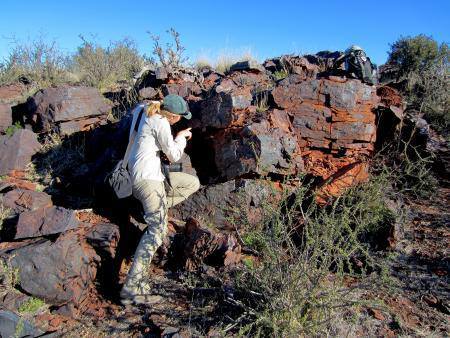First manganese, then the world!The rocks you see here being sampled by Caltech grad student Jena Jo
First manganese, then the world!The rocks you see here being sampled by Caltech grad student Jena Johnson look rather ordinary; somewhat weathered and covered by dirt, but they sit in a key spot for the development of life as we know it. These rocks, found across large portions of South Africa, are just over 2.4 billion years old. That age means these rocks come from the time just before the rise of oxygen, when the mechanism that would allow for photosynthesis was evolving.These rocks are kinda interesting too. They contain large amounts of manganese, and that’s not a rock type we see very often today; it’s not easy to concentrate manganese into big thick layers of rock.But right around the time oxygen started being produced by photosynthesis, it could have been possible. Manganese has multiple “oxidation states”, meaning manganese atoms can gain or lose variable amounts of electrons. Manganese (II) has a +2 charge and can dissolve easily in water. Manganese (III) or (IV) don’t dissolve in water; they precipitate out and form solid oxides like those seen in this unit.That fact makes this unit really interesting because manganese oxides like these could be formed from the processes giving rise to photosynthesis. Manganese (II) could have been dissolved in the ocean and then converted to manganese (III) or (IV) as life began figuring out the steps in photosynthesis.Even more interesting…the chemical pathways involved in photosynthesis today actually involve manganese. That could indicate reactions involving manganese were involved in the evolutionary steps along the way, and these manganese-rich layers from the right time period might record that step.How could you tell geologically if that were the case? Well, this unit could do it. Researchers would need to verify that the manganese oxides formed from the seawater but at a time without free oxygen. Basically that would mean that some organism had evolved the ability to take sunlight and use the energy from it, giving off oxidized manganese as a byproduct, but hadn’t yet figured out the next step of giving off oxygen as a byproduct.Using cores from drilling efforts led by the Agouron Institute, researchers from Caltech in the group of Professor Woodward Fischer have done just that.They first examined the cores in extremely high detail to understand the textures in the manganese oxides and verified that they were deposited as sedimentary grains. The manganese is distributed throughout the rocks in thin layers and grains and is associated with carbon bearing the isotopic signatures of biologic material. These results mean that the manganese was deposited in a sedimentary environment; it came directly out of the ocean rather than being added by some other process.Secondly, the researchers examined other minerals in the sample and found pyrite, a diagnostic mineral for the lack of free oxygen. When oxygen is present, pyrite rusts; we even see this today, the iron is oxidized and the sulfide becomes sulfate. This mineral strongly suggests that the manganese oxides formed from waters without free oxygen.Finally, the researchers also analyzed sulfur isotopes. One of the best pieces of evidence we have for when oxygen began to rise is a change in the behavior of sulfur isotopes; without going into too many details, you can literally say “yes or no” to oxygen being present using sulfur isotopes. That measurement agrees; there was no free oxygen present when these manganese nodules formed.This group has found rock units that capture a snapshot in evolution. Some sort of bacterium developed the ability to take manganese from the water, use manganese in a process that collects sunlight, grow itself using some of the energy from that reaction, and discard the newly-oxidized manganese back into the ocean, where it would float to the bottom as a sediment.The bacterium could live off of that process, but it could only do so as long as it had an ample supply of manganese. If the manganese ran out, it couldn’t continue that process. That is, unless it could find in the water some other, more abundant element to use in the process. Eventually, an organism would figure out that water could do just that; it could hold onto the manganese, take what it needs from the water, and release oxygen as the byproduct.This rock unit is a snapshot of one of the major evolutionary steps that gave rise to life as we know it, and this research has put together a piece of that remarkable story.-JBBImage Credit: Caltechhttp://www.caltech.edu/content/stepping-stone-oxygen-earthOriginal paper (PNAS, Subscription required):http://www.pnas.org/content/early/2013/06/20/1305530110.full.pdf+html -- source link
#science#oxygen#biology#south africa#precambrian#proterozoic#archaean#geology#manganese#chemistry#caltech#isotope
